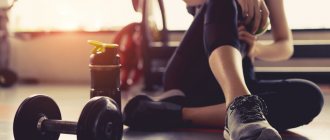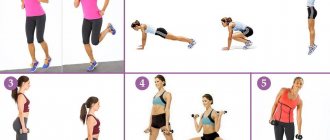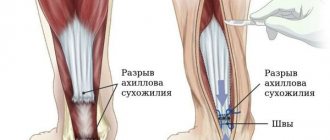Table
There is no precise scientific data to estimate the time required for a full return to sports activities. There are many factors that can affect the result: age, level of load, diseases of the musculoskeletal system, genetics.
But there are personal observations of athletes. Let's try to bring the data together:
| № | Kind of sport | Recovery time, h |
| 1 | Stretching | 24 |
| 2 | Body-building | 48 |
| 3 | Powerlifting | 72 |
| 4 | Martial arts | With general physical fitness – general physical fitness – 48, without – 24 |
| 5 | Strength training | 48 |
| 6 | Cardio training | 24 |
| 7 | Run | 48 |
Average time
A simple rule is that the larger the muscle, the more time it will need to rest after training in hours. There are those who are able to return to work within a minimum period of time: abdominal muscles, biceps femoris. The latissimus dorsi muscles take the longest to return to normal. They should not be loaded more than twice a week.
The average time for tissue regeneration is 48 hours.
It is necessary to take into account the fact that the nervous system, ligaments, joints and tendons need restoration.
The whole truth about training the abdominal muscles
When it comes to your abs, you should train them just like you would any other muscle group, depending on how you want them to look. And don't forget about a proper diet. No matter what anyone says, the abdominal muscles are “prepared” in the kitchen. If you want to have pumped up abs, then 90% of this is due to a strict diet and only 10% of this depends on physical exercise. You can have the best exercise routine in the world, but if you have a layer of fat on your belly, no one will notice. Therefore, the first thing you need to realize is that proper diet is the single most important factor. There is no other way, unless you are the lucky owner of good genetics that allows you to eat whatever you want and not gain weight. Now let's take a look at the truth about abdominal training.
Frequency
One of the frequently asked questions is: “How often should you exercise your abdominal muscles?” Some people think this needs to be done every day. Now ask yourself: “When do muscles actually grow and become stronger?” Answer: “During rest.” Therefore, if you force these muscles to work every day, then one of two things happens: 1. You do not allow the muscles to recover between classes, which leads to a further deterioration in their overall condition and reduced results, or 2. You do not strain them hard enough, which does not prevents their growth. No matter which of the above problems you have, the situation needs to be corrected. To determine how often you should train your abs, you also need to consider your overall training goals. If you're only interested in strength, you'll want to use heavy weights. In this case, you need more time to recover, therefore, two to three times a week is enough. If your goal is to strengthen the spine area, then the exercises should be performed 3-4 times a week, lifting less weight more times. Some believe that since the abdominal muscles are smaller, they can also have less recovery time. But this is completely wrong; in terms of their chemical composition, the abdominal muscles are exactly the same as, say, the muscles of the chest. The more you work your muscles, the more damage you cause, and the more time you need to rest. Therefore, there are no additional benefits to exercising your abdominal muscles every day.
Quantity
Now you need to decide on the volume of training and the weight to be lifted. Should I lift my torso 100 times or is 8-12 times enough, as with other exercises? Here again you need to remember your goals. You need to understand that the weight lifted and the total number of lifts lead to completely opposite results. If you want to completely eliminate injuries during training (and, of course, demonstrate to everyone those same notorious “abs”, which, as we have already determined, mainly depend on your diet), then two to four approaches will be enough. It must be remembered that the abdominal muscles adapt very quickly to the exercises performed, so it is necessary to regularly modify your exercises, especially if you use weights during the exercises. You need to choose three or four different exercises and do one every week. You can do the same exercise several times in a row, but after that move on to another. On the other hand, if your main goal is to build strength, then a few (3-6) reps, gradually increasing to 6-10, are sufficient. This is quite enough to give the necessary impetus to muscle growth in this area, on the assumption that the abdominal muscles will receive the necessary rest between exercises.
When should you train your abdominal muscles?
Another factor you should consider is when to train your abs. In this regard, it must be remembered that the abdominal muscles are involved during almost all physical exercises with weights. And if the muscles are tired during lifting of the torso (legs) during exercises only for the abs, then during other exercises this can lead to injury, which often happens if you use heavy weights. In order to avoid injuries, train your abdominal muscles at the end of your entire complex.
Selection of exercises
Finally, you need to decide on the types of exercises to train your abdominal muscles. A common misunderstanding arises because many people believe that you need to do separate exercises for your upper and lower abs. In fact, it is very difficult to separate these two muscle groups, and when performing abdominal exercises, they all interact simultaneously. What you really need to pay attention to (if your goal is to develop strength) is to reduce support during exercise (as much as possible). This will be much more effective in strengthening muscle tissue. A good choice when identifying abdominal exercises would be an exercise ball, a clock exercise (rotating your legs in a circle while lying on the floor), or working with an assistant with medicine balls. Among other things, try to choose exercises that provide a large amplitude so that you can strengthen the abdominal muscles from all possible angles. Here, lifting your torso with bends, lifting your legs with weights, and bending forward while holding a cable with a suspended weight are suitable. If you can't think of any new abdominal exercises, don't hesitate to approach a trainer. There are many exercise equipment that you can use to improve your exercise routine, and a trainer will be able to help you with this. In addition, in order to prevent muscles from adapting to exercises, a trainer can simply modify your exercises slightly (change the starting position of the body, for example), and your muscles will continue to develop. DISPLAY THE MYTH Remember these simple ab workout basics. This is one of the muscle groups that many people are concerned about. Don't forget that the lack of results and improvements in this case is mainly caused by poor diet and not exercise, so pay attention to the tips above and get those very “packs” you dreamed of. We will talk in more detail about proper nutrition “for cubes” in our next article. *We welcome the distribution of our materials, but only if you provide a hyperlink to the Youth Portal Xage.Ru
How to catch supercompensation
There are 4 recovery phases:
- Fast.
- Slow motion.
- Super compensation.
- Deferred.
We are most interested in the third point. This is the best time to start a new workout. The body is preparing for increased load, so it actively builds muscle tissue. But how can we determine that this moment has arrived?
Currently there are no exact methods. Perhaps science will eventually be able to determine the hour “X” with an accuracy of the minute. In the meantime, let's try to reason logically. All we have is an approximate average recovery time. It is equal to 48 hours. This means that you need to select intervals through trial and error. But it’s better to take the same two days after training as a basis. You can think something like this:
- Muscles don't grow, but the athlete feels rested ? This means you can reduce recovery time. Moreover, Olympians train 3 times a day and manage to take prizes.
- Muscles are at the same level, but fatigue knocks you down ? It makes sense to increase the pause between classes. For example, up to 72 hours. If progress begins, then everything is going in the right direction.
Muscle tissue increases in volume, but the athlete is constantly under stress? Sooner or later, overtraining will occur. And then a rollback is just around the corner.
How to speed up recovery?
After every workout, we dream that our muscles will recover faster, because then they will stop hurting. These are six proven ways to speed up recovery after high stress.
Staying active
The problem with slow recovery for many people is inaction. After training and the next day, you want to move as little as possible, giving in to this desire slows down muscle recovery. In order to recover quickly, you need to remain active even on rest days. When moving, the joints replenish their reserves of synovial fluid, more blood flows to the muscles, and recovery should be active.
To drink a lot of water
If you don't drink enough fluids after a workout, the muscles in your dehydrated body begin to ache even more. After exercise, breakdown products are formed in the body, which increase pain. You should drink 2-3 liters of water a day to flush out waste products and relieve pain.
Remedies for muscle pain
Muscle pain can be so severe that any activity becomes difficult. But you still need to move, so if the pain is very severe, it is advisable to use ointments and creams for the muscles. Such remedies can have a cooling or warming effect, the principle of action of each is to relieve muscle tension and overcome pain.
Foods High in Potassium
Post-workout nutrition is a special diet, it must correspond to the task of recovery. To speed up muscle recovery, you need to eat as many foods as possible with a high potassium content; this trace element plays a decisive role. The best sources of potassium are bananas and potatoes; these foods are versatile and never get boring.
Cold
One of the simplest, but most effective means for muscle recovery is cold. You can use the power of cold in different procedures - a cool bath or shower, a cold heating pad or ice packs. Exposure to cold does not have an immediate effect, but it does relieve muscle pain much faster.
Chocolate milk
Chocolate milk provides an excellent combination of nutrients for muscle recovery. First of all, these are protein, calcium and flavonoids. You rarely find chocolate milk in stores without a lot of harmful additives, so it’s better to prepare the drink at home. It is not necessary to use cow's milk; a drink based on almond or coconut milk is also very nutritious.
What you do after a workout greatly influences your performance in the next workout. If you want to be productive in every session, then strengthen your muscle recovery program. Use these methods to speed up muscle recovery and quickly get rid of muscle pain.
Anatomy
One definition of recovery is the ability to maintain and exceed results in a particular activity. That is, the body must be able to keep pace, overcome stress and adapt to new loads after completing competitions or exercises.
In the first couple of years, theorists of sports medicine proceeded from the concept of homeostasis - the desire to maintain a balance between physiological processes. The body, under normal conditions, wants to remain in balance. But what happens after exercise? Stress hormones are released that disrupt “peace and order.”
Every workout is extreme. But it can be controlled. When an athlete comes to the gym and carries iron for an hour, he exposes himself to stress. The body tries to turn on defense mechanisms and return to normal. Alternatively, protein synthesis begins. This is an attempt to make the muscles bigger and stronger in preparation for future stress.
The importance of muscle recovery after exercise
Training and recovery are two opposing processes of one whole. Yin and Yang, white and black, destruction and creation.
Recovery after training, in a very simplified diagram, can be represented as follows:
- When you train in the gym, you destroy muscle tissue.
- Within a few hours after class, all your physical indicators decrease. Strength, endurance, muscle size, performance and much more.
- The body has experienced stress in the form of physical activity. And for several hours he thinks about what to do to be prepared for such stress next time.
- The first step of the body is the restoration of all working substances and substances inside the muscle cell (which were spent during training). This process is called compensation.
- Then the body begins to store these substances a little more than usual. More than before training. The process of accumulation of nutrients in the muscle above normal levels is called supercompensation.
Most gym goers don't even realize that they are training for one thing only. To launch supercompensation!
Consequently, managing the supercompensation process is managing the restoration and growth of muscle mass, strength, endurance, and performance.
Why do muscles work?
Our muscles do not turn on by themselves, they need an electrical impulse. This means that we cannot do without the autonomic nervous system. It consists of two branches:
- Sympathetic (SNS) . What they call “freeze, fight or flight.” Activation of this branch helps you jump high, run fast, and lift weights.
- Parasympathetic (PNS) . The system is responsible for the digestion of food, the synthesis of new tissues, the process of recovery and rest.
The goal of development is to learn to control the nervous system. If you need to train for a long time and build muscle mass, then you need to “turn on” the SNS. But when the time comes to relax and sleep soundly, healthyly, you can’t go without the PNS.
But how to monitor the balance of the nervous system?
How long does it take for muscles to recover?
Once upon a time, science gave clear and straightforward deadlines for how long a muscle recovers after training.
It was believed that small and hardy muscles (calves, forearm, abs) recovered quickly from power load. Usually the deadline was 1-2 days. Shoulders, biceps, triceps – 2-3 days. Well, large muscle groups (hips, chest, back) - 3-5 days. Accordingly, there were recommendations to pump small muscles 3 times a week. And large ones 2 times a week.
Life and practice have shown that scientists were slightly mistaken in the timing of muscle recovery.
And this happened because they determined muscle recovery in a “test tube”. At the same time, no allowance was made for the complex restoration of the entire body.
After all, a person consists of more than just muscles!
During strength training, it is not only the muscles that experience severe stress. The work involves the osseous-ligamentous system, the cardiovascular system, the central nervous system, and the hormonal system.
It turned out that muscles cannot grow until the body recovers comprehensively. Therefore, the timing of muscle recovery after strength training was revised.
Large muscle groups recover in 5-7 days. And small ones - in 3-5 days.
Heart rate variability monitoring
Heart rate variability (HRV) is a change in the interval between two adjacent myocardial contractions. The measurement technique in Russia is promoted by Roman Markovich Baevsky, Doctor of Medicine.
The technology emerged in the 1960s. Scientists analyzed the pulse and cardiogram of the astronauts. As a result, the conclusion emerged that the main indicator of the body is the ability to adapt.
A domestic company is working in the direction of the HRV method, which has developed a special Engy Health application and a professional cardiac sensor Engy Beat. When playing sports, the application shows the current state of the body:
- Energy . It tells how ready the body is for stress.
- Stress . The scale displays your stress level.
- Recovery . Reflects the state of the parasympathetic nervous system.
The smart gadget analyzes the heart rhythm and produces a ready-made, visual result. Like at a traffic light. Green – the body is normal. Red – danger of overtraining.
To connect to the application you need a professional heart rate monitor. Top-end Apple Watch models and devices such as Garmin HRM Dual, Polar H7 and Cardiosport TP3 are suitable.
Will the sense of smell return after coronavirus?
All that doctors can say so far is that normalizing the condition of the mucous membrane will ensure that the sense of smell returns a little faster than if nothing is done at all. Due to the unfavorable environmental situation in large cities and the characteristics of central heating, the mucous membrane may dry out and crack. To avoid this, Kartashova advises using elimination therapy - rinsing the nose with an isotonic solution of sea water. It can be bought at a pharmacy.
It needs to be a standardized solution; there is no need to try to prepare it at home, because patients, as a rule, mix it incorrectly, inaccurately, and may add something else: from iodine to garlic. And this can only worsen the condition. ENT doctors also do not recommend using saline solution, because the concentration of salt in it is different, this is not exactly what is needed.
The most important thing: do not pour or drip anything that comes to hand into your nose.
There is no need to prepare solutions yourself, apply oils or use antiseptics - this does not help, but it can make things worse. A lot of patients who have had COVID-19 are beginning to try to regain their sense of smell by simply washing their nose with everything, including aggressive antiseptics, which are not intended for the nasal mucosa at all - they are used to treat inflammatory pathology of the pharynx. The result is a burn of the nasal mucosa. It is very easy to burn. If the loss of smell is very concerning, you can consult a specialized doctor after recovering from COVID-19. You will need an otorhinolaryngologist, also known as an ENT specialist.
Influence of factors
Typically, specialists who develop training schedules take into account 3 factors:
- Age.
- Target.
- Lifestyle.
A young athlete in his 20s experiences little stress. Usually he has plenty of time, no obligations to people and credit institutions. Therefore, an athlete can easily endure high stress and quickly recover from it. But if a person is in his 40s and working tirelessly to support his family, his stress level is high and his ability to recover is low.
How long does recovery take?
Some experts say that, according to their own observations, loss of smell is the first symptom of coronavirus infection. But there are also those who are confident that this symptom will appear only on the 6th or 7th day after infection. In some cases, anosmia may be the only symptom of COVID-19 without the person complaining of nasal congestion or runny nose. For this reason, if problems with the sense of smell arise, it is recommended to contact your local physician and be observed in a clinic at your place of residence. Many people are interested in the question of how long it takes for the sense of smell to recover after coronavirus.
But a problem with the olfactory system is not always related to COVID-19.
Therefore, specialized tests are needed to determine the exact cause. Differential diagnosis in this case can be carried out with psychological reasons, allergies, nasal polyps. If the sense of smell and taste has not been restored after coronavirus, the reason may lie in the physiological characteristics of a particular person. In most cases, both of these features are restored 14 days after the officially established recovery.
Individual citizens have recorded the return of their sense of smell and the ability to taste food before the tests showed a negative result. At the same time, others needed more time, sometimes up to several months. In any case, complete recovery sooner or later occurred, and the person again felt the tastes and smells as before the illness. So far, the phenomenon of anosmia and loss of taste has not been studied deeply enough to give an accurate answer regarding the timing. At the same time, there are concerns from some scientists that even if taste is restored, problems with the sense of smell may remain for life.
Dependence on loads
To understand how much effort an exercise takes, you need to monitor the statistics of approaches and repetitions. In this case, the formula for evaluation will be as follows:
Sets x reps x load.
Then two workouts according to the 5x5 scheme will look like this:
- 5 sets × 5 reps × 90 kg = 2250 kg total load.
- 5 sets × 5 reps × 180 kg = 4500 kg load.
It seems that each workout involves 25 repetitions, but the level of fatigue is completely different.
Run
Using the example of running, you can understand how much time it takes for muscles to recover after training. This sport affects the same muscles. The only difference is additional conditions such as duration and relief.
Running on hilly terrain with ups and downs is especially taxing on the body. This is due to the fact that the muscles need to constantly expend effort on braking and shock absorption. Therefore, the effect of soreness is especially intense.
According to a study published in the British Journal of Sports Medicine, an athlete will need 48 hours to rest before returning to running.
Hurt does not mean growing
“There is an opinion - the more it hurts, the better the workout,” says Alexander Krutousov , personal trainer at the Zupre sports club. - Not at all true! Pain is not a necessary sign of a good workout, rather the opposite. I remember how, at the age of 15, I pumped up my biceps “great” for the first time - for two weeks then I couldn’t straighten my arms. Hyperintense muscle pain is an unhealthy consequence of training that can discourage a person from engaging in fitness in general. Especially girls. If you find it difficult to move because of the bench press you did the day before, it will take a lot of effort, both physical and mental, to get back into the gym. So it’s better to predict this in advance and not get overloaded.”
Takeaway : Start thinking about muscle recovery before you start training.
Training schedule
In most cases, professional trainers recommend guided by your own feelings. Is it hard to work out 4 times a week? This means that you only need to devote 3 days to sports. Otherwise, there will be a risk of falling into a period of constant stress. This is destruction, not growth.
A training week might look like this:
- Monday . Maximum effort. Lower body.
- Tuesday . Rest.
- Wednesday _ Maximum effort. Upper body.
- Thursday . Rest.
- Friday . Moderate effort. Lower body.
- Saturday . Moderate effort. Upper body.
- Sunday . Day off.
At maximum loads, the athlete will be able to train only 2 times a week. Therefore, 48-72 hours of time are needed for muscle recovery. But you still need to wait until the nervous system returns to normal.
Of course, if you work only 2 days and rest the rest of the time, there will be no progress. Therefore, it is impossible without moderate training. They will allow you to stay in good shape.
If the goal is intensive growth of muscle mass, bodybuilding trains using a split system. Then the maximum load should be done on the day when the legs, chest or back “sway”:
- Monday . Legs.
- Tuesday . Rest.
- Wednesday _ Breast.
- Thursday . Rest.
- Friday . Back.
- Saturday . Arms and shoulders.
- Sunday . Day off.
This distribution allows you to work with a minimum level of stress. Groups of muscles recover faster than all muscles at once.
Should I stop training completely?
To the question of whether it is necessary to take breaks in training, we will answer unequivocally in the affirmative.
Ordinary gym goers are sure that it is absolutely forbidden to take a break from training. But athletes regularly work out, taking breaks from training, and receiving additional bonuses from this in the form of muscle growth.
The difference is that a complete break in training for amateurs occurs spontaneously, under the influence of life circumstances. And it can last from 2-3 weeks to several months.
With prolonged rest, regression in physical fitness indicators actually occurs. Some muscle mass, strength and endurance are lost, and upon returning to the gym you will have to spend several months restoring your former condition.
Unlike amateurs, professional athletes use pauses in exercise as part of the training process.
For this purpose, breaks from exercise in the gym are taken for no more than 7-10 days.
This time is enough to restore the hormonal and central nervous systems, muscles and ligaments. The body is already ready for a new stressful effect.
In this case, there is no loss in muscle mass and strength, the previous results return within 1-2 weeks of inclusive training, and the rested body still has the resources to progress further.
A pause from basic training is taken in many sports, using it as one of the methodological techniques to improve athletic performance.
Typically, a complete (but active) rest of 7-10 days is arranged every 3-4 months of regular classes.











